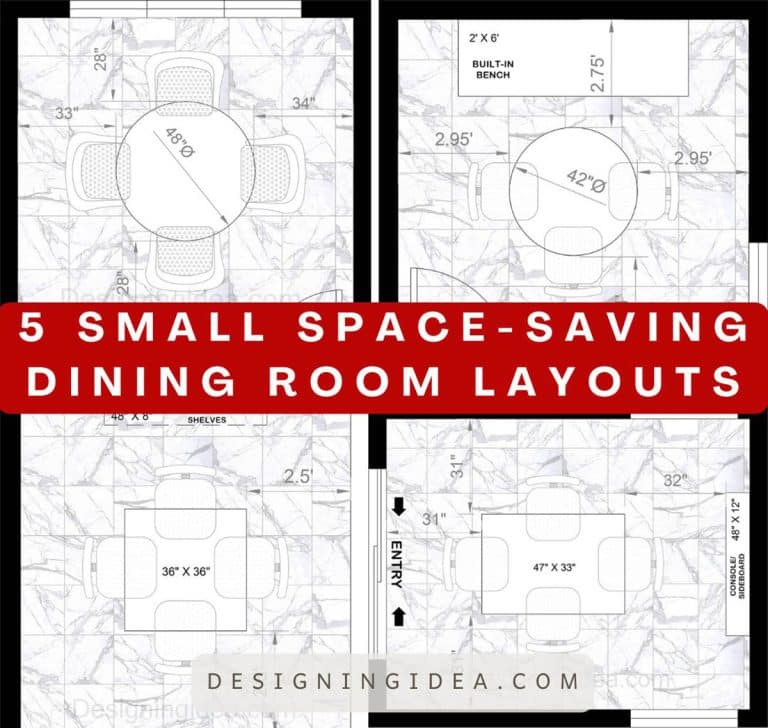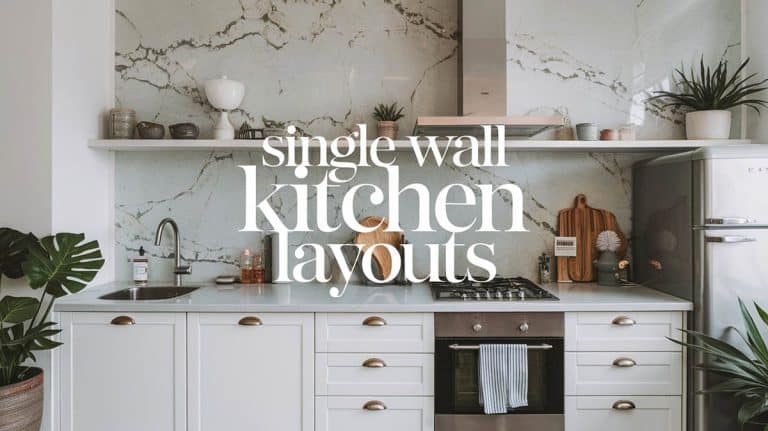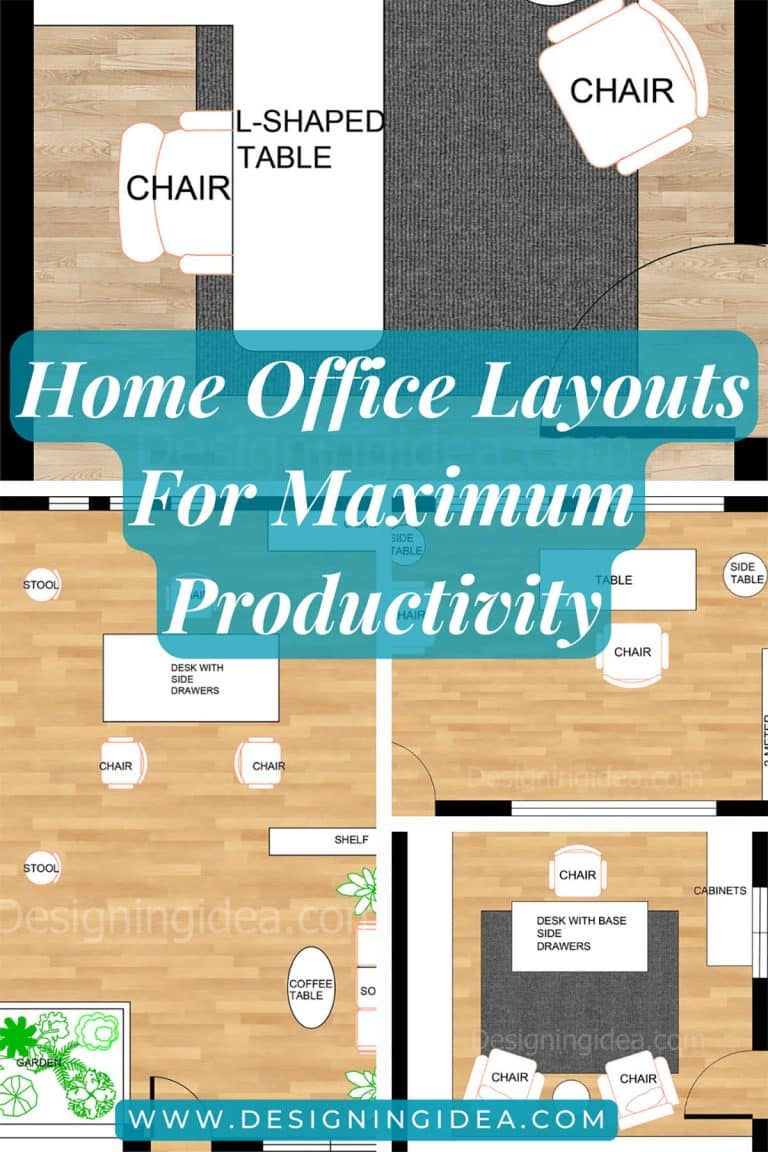5 Laundry in Master Closet Floor Plans: Washer & Dryer Layouts
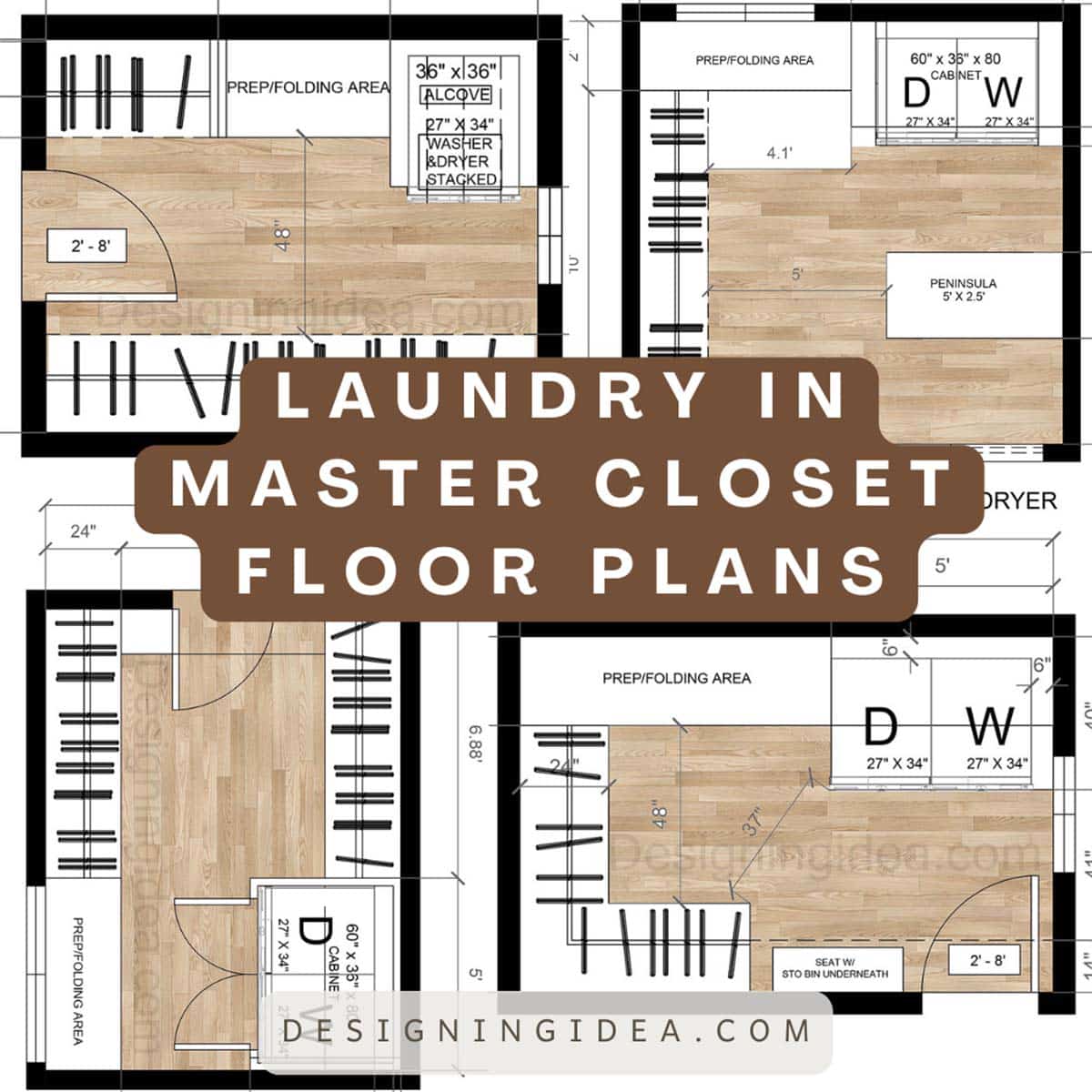
If you’re looking for the ideal way to combine a laundry space into your master bedroom closet, then these designs might be perfect for you. These layouts bring together split-use areas that can be used for dressing, clothes storage, washing, and folding into one organized room. Whether you’re working with a compact space or an expansive square footage, we’ve got you covered with these five laundry in master closet floor plans.
8×10 Laundry Closet Layout With Stacked Washer-Dryer Nook
By installing a stacked washer-dryer into a 36-inch corner alcove and lining two full walls with double-rod storage, this 8 × 10 plan turns a modest 80 square feet into a highly efficient laundry room space.
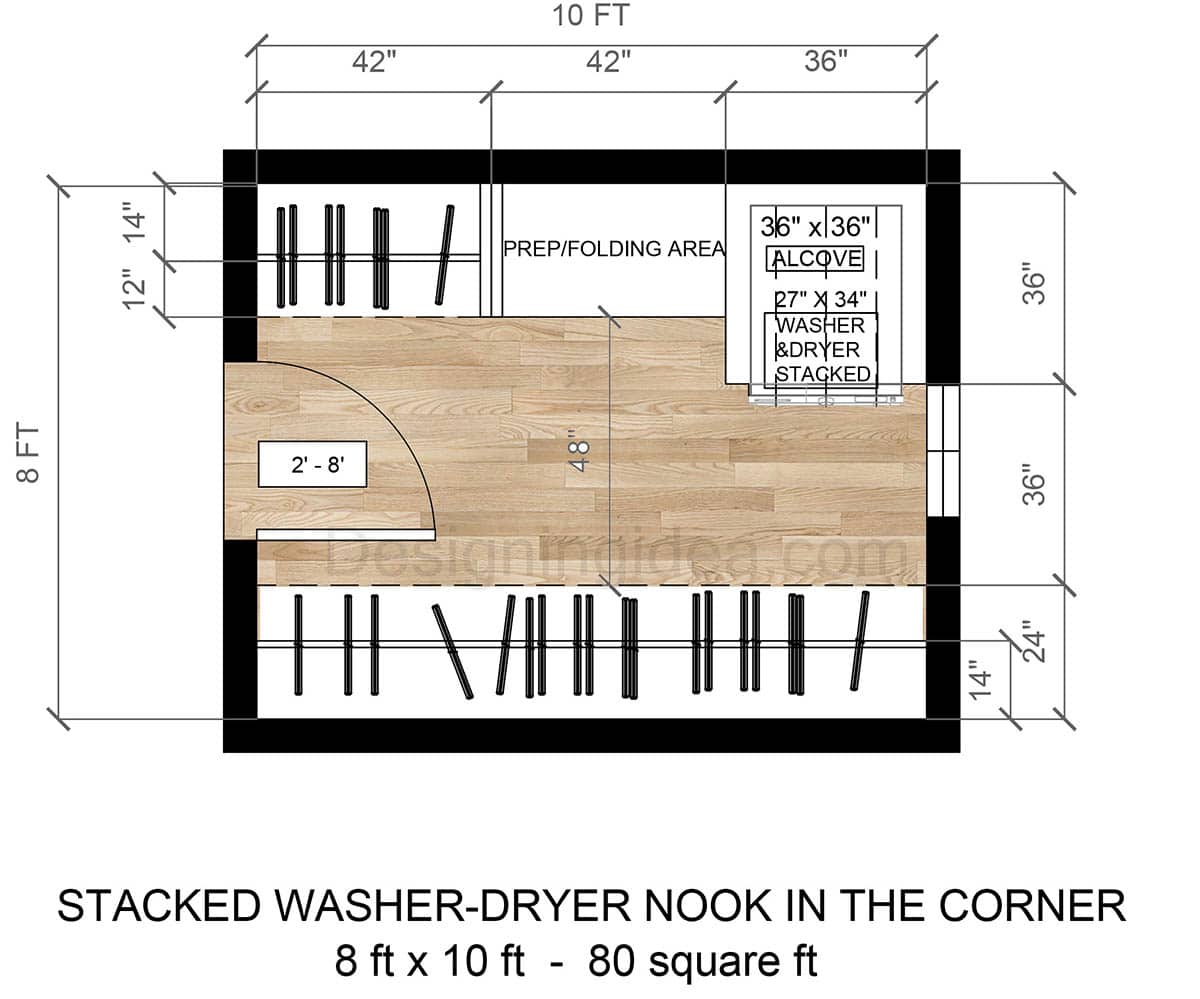
Layout Details: This storage-friendly laundry room occupies a compact 8-by-10-foot rectangle layout (80 sq ft) with the entry door located on the left-hand (or west) wall. The 2-foot-8-inch door swings in against that same wall, so it doesn’t get in the way of circulation. Once inside, you step into a 4-foot-wide central aisle that stretches all the way to the far (or east) end, and is wide enough for a rolling basket or for two people to pass by each other.
At the northeast corner, a 36-inch-square nook holds the stacked washer and dryer unit (each machine about 27 inches wide by 34 inches deep). The alcove leaves a full 36-inch clear zone in front, making loading or unloading more comfortable. Directly opposite the machines on the north wall runs a 42-inch-long, 24-inch-deep countertop that doubles as a prep and folding station. The base cabinets allow slide-out hampers that can tuck beneath to hide detergents and supplies.
Storage lines the remaining two walls. On the upper half of the west wall, a 12-inch-deep shelf is paired with dual hanging rods mounted 14 inches out from the wall, offering a 42-inch span for short-hang items. The entire 10-foot-long south wall repeats that shelf-plus-double-rod setup, creating an impressive run of hanging space while still leaving a 36-inch passage at the east end for comfortable movement around the appliances. Altogether, the arrangement keeps task zones clearly defined, entry and circulation in the middle, machines and folding to the north, and ample storage along the west and south.
Dimensions:
- Closet Size: 8 ft x 10 ft (80 sq ft total).
- Laundry Nook: 3 ft wide x 3 ft deep alcove for the stacked unit. (Stacked washer/dryer appliances are typically 27 in wide x 32 to 34 in deep and 74 to 76 in tall.
- Access and Clearance:
- Provide at least 36 in clear floor space in front of the appliance for safe door swing and loading.
- Ensure a minimum 36 in corridor leading to or past the washer/dryer (common egress width in many jurisdictions).
- Shelving and Hanging Rods:
- On the opposite side (or the adjacent walls), install 12 to 16 in deep shelves and rods.
- Provide 24 in minimum clearance from the wall to accommodate hanging clothing.
- Ventilation/Electrical:
- Allocate 4 to 6 in behind the stacked unit for venting and hose connections.
- Plan for a 120 V electrical receptacle (gas dryer option would require a gas line plus a 120 V outlet, electric dryer typically requires a dedicated 240 V outlet).
Why It Works
- Generous storage space. Frees up the rest of the closet for storage.
- Good for the corner. Stacked units fit in tight corners well.
- Minimal plumbing/electrical. Eliminates extra rework if you have an adjacent plumbing/electrical wall.
Design Tips:
- Use the corner for the appliance. Stacking the appliances in a dedicated nook adds a little separation from your clothing and keeps noise in one corner, freeing up two walls for storage.
- Double-rod strategy. Upper and lower rods along the longer walls almost triples the hanging capacity you’d get from a single rod.
- Generous central aisle. The 4-ft-wide aisle lets two people pass, accommodates rolling hampers and helps conserve room for bins or baskets.
- Dedicated folding zone. A 42″ folding counter with slide-out hampers underneath offers surface area for tasks.
- Dhoose durable, easy-clean finishes. Select moisture-resistant laminate, quartz, or granite for the counter and a slip-resistant LVP or porcelain tile floor to resist spills.
8×12 Laundry Room Closet Floor Plan With Side-by-Side Washer and Dryer
This 8 × 12 closet layout tucks full-size machines under a folding counter and uses an L-shaped storage design to create a multi-tasking, mudroom-friendly laundry room..

Layout Details: The room stretches 12 feet wide and 8 feet deep (96 sq ft) and directly inside is a built-in seat about 3½-feet long with a pull-out storage bin underneath. This is ideal for placing baskets or boots while keeping the central aisle clear. Along the full length of the upper wall sits a 24″-deep countertop dedicated to prep and folding. The last 5 feet of that counter shelters a side-by-side washer (right) and dryer (left), each a standard 27″ × 34″ sized machine. The appliances are pushed back so only door fronts project, with a 6″ buffer on the far right to keep the doors from resting directly against the sidewall and a full 40″ clear in front for loading and unloading clothes.
Storage rods on the west wall in an L-shape offer a 24″-deep vertical bank of adjustable shelves at the corner and transitions into dual hanging rods beneath a 12″ shelf that extends 6 feet down the wall and then turns onto the south wall for another short run. This setup yields nearly 14 linear feet of double-rod hanging plus open cubbies for baskets, detergent, or seasonal gear, all within easy reach of the folding counter.
Dimensions:
- Closet Size: 8 ft x 12 ft.
- Laundry Area:
- Minimum 5 ft wide section to accommodate standard side-by-side washer/dryer (27″ wide.)
- 34 to 36 in deep (typical depth is 30 to 33 in, plus venting space).
- Place a 2 ft deep countertop directly above the appliances at a height of 40 to 42 in.
- Clearances:
- 36 in of clear floor space in front of each appliance.
- 36 in minimum walkway.
- Hanging and Storage:
- 12 to 16 in deep shelving and a 24 in clothes rod projection.
- Consider overhead shelving above the folding counter.
- Plumbing/Electrical:
- Place hookups behind the units with 6 in gap for hoses/vent.
- Provide a drain pan under each appliance if local code or best practices require it (especially for second story installs).
Why It Works
- Space to fold. Offers a dedicated folding surface.
- Full-size units. Side-by-side units are easier to maintain or replace individually if needed.
- Looks more attractive. Looks more built-in and seamless, matching closet cabinetry.
9×12 Full Laundry In Wardrobe Design With Hidden Appliances
By hiding the washer and dryer in a cabinet and converting the remainder of the walls to hold double-rod hanging and a dedicated folding counter, this design offers a full-service laundry room that feels like a bespoke walk-in closet.
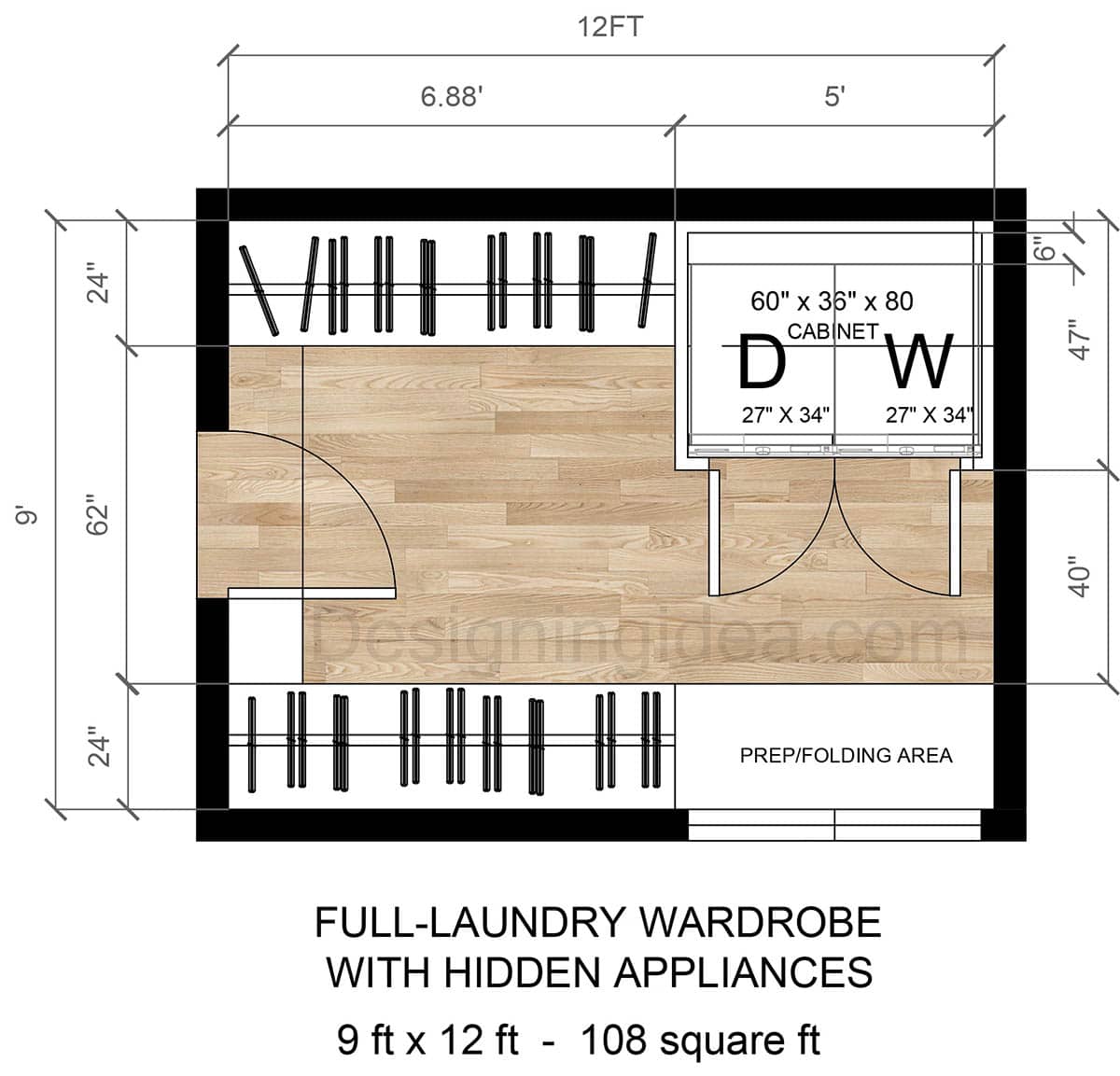
Layout Details: This laundry floor plan uses a disguised wardrobe to hide the washer and dryer to help muffle noises and look more appealing. The 9 × 12 foot space (108 sq ft) opens to a 5-foot-plus aisle that runs unit you get to the appliances, then offers 40″ of maneuvering room. The built-in cabinet for the appliances measures 60″ W × 36″ D × 80″ H and conceals a full-size washer and dryer set behind double doors. Each appliance is 27″ W × 34″ D and tucks flush inside, while the cabinet face aligns with the countertop so nothing protrudes into the 40″ walkway. This clear zone in front lets both the cabinet doors and the appliance doors swing open freely for loading and unloading clothing.
Clothing storage is on both the upper and lower walls, with a 6′-10″ stretch of 12″-deep shelf supporting dual hanging rods. The folding counter is mounted at a standard 36″ height and is roughly 4½ feet long, and sits directly opposite the appliance cabinet so fresh laundry can move from drum to worktop in one smooth motion. Base drawers beneath help keep visual clutter out of sight.
Dimensions:
- Closet Size: 9 ft x 12 ft.
- Wardrobe Cabinet:
- 60 in wide x 36 (47”) in deep x 80 to 84 in tall cabinet.
- Pocket, bifold, or swing doors that open to reveal side-by-side or stacked appliances.
- Include built-in overhead shelves for detergent and laundry supplies.
Why It Works
- Visually hides the appliances. This keeps the closet’s aesthetic unified.
- Protects the machines from dust and debris.
- Reduces machine noise. It can include noise-dampening features if designed carefully.
Design Tips:
- Hide the machinery. Full-height cabinet doors turn utilitarian appliances into an unobtrusive “wardrobe,” letting the room read more like a dressing area than a laundry.
- Double-rod efficiency. Stacking two hanging bars under a single shelf creates more linear storage without increasing the footprint.
- Clearance counts. Maintaining a 40″ buffer in front of the cabinet ensures appliance doors and cabinet doors can open simultaneously without conflict or pinched fingers.
- Task-lighting zones. Use recessed puck lights inside the cabinet to illuminate the washer and dryer tops and fronts, while an LED strip under the upper-wall shelf illuminates the folding counter.
- Moisture-smart materials. Choose a quartz or high-pressure laminate worktop and luxury-vinyl plank for flooring to resist the inevitable splashes and humidity from laundry cycles.
10×10 Bedroom Laundry Closet Layout With Stacked Washer-Dryer with Utility Sink
This closet/laundry layout splits the room into two by placing a stacked washer-dryer into a corner alcove, adding a sink to a folding counter, and lining the opposite wall with double clothing hanging rods. This effectively turns a simple design into a fully loaded bedroom laundry station that still feels spacious.
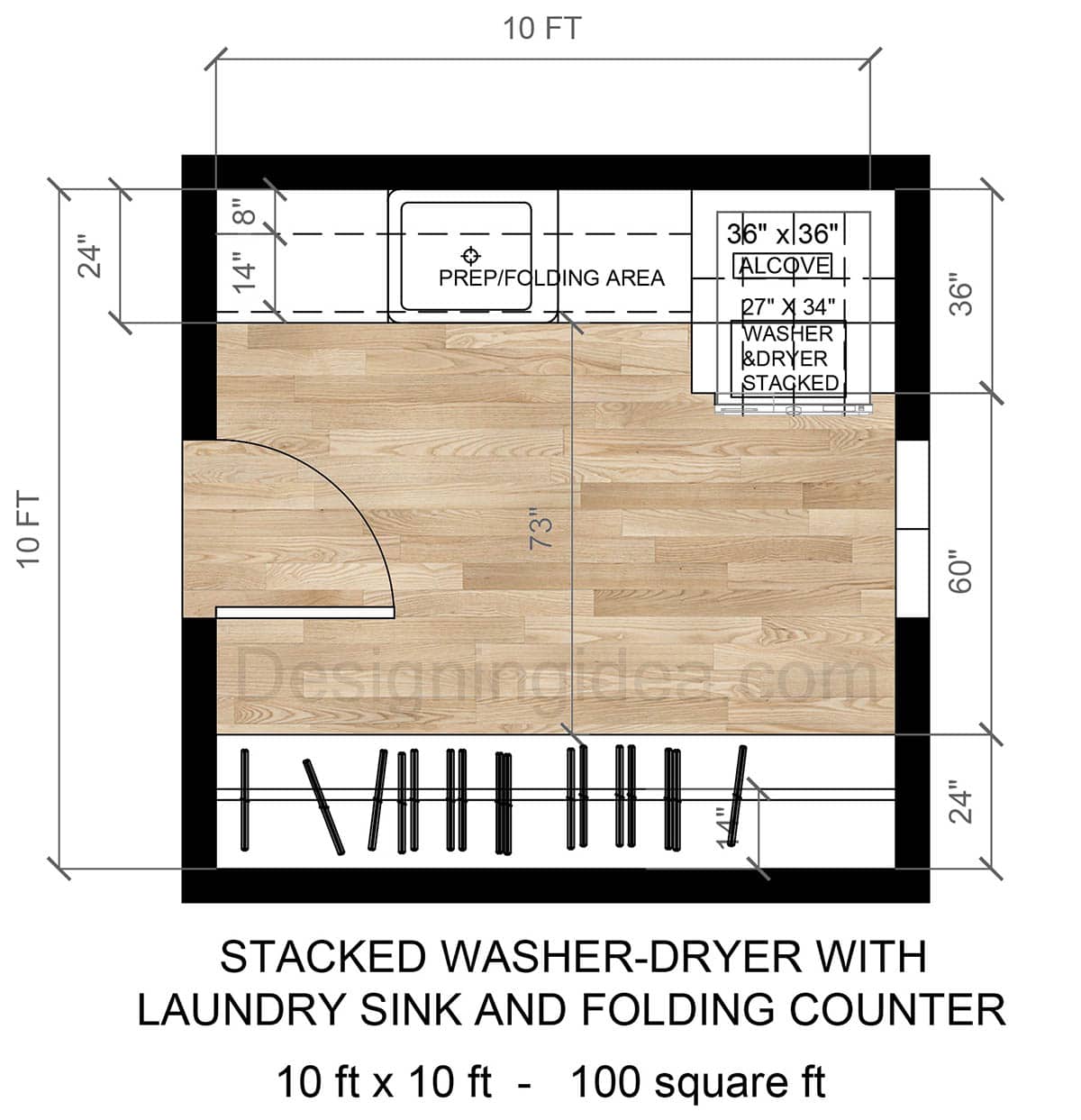
Layout Details: For those looking for an even split between laundry and clothes storage this is a good solution. The laundry-closet is a perfect square, measuring 10 × 10 feet, or 100 square feet with one side devoted to storage and the other laundry. As you enter the doorway, the room’s upper wall is fitted with a full-length 24-inch-deep countertop that serves double duty. The middle portion houses a utility sink, with countertop on either side as a prep-and-fold surface. Overhead wall cabinets (shown dashed) provide closed storage for detergents and cleaning supplies without crowding head height. At the far corner, a 36″ × 36″ alcove conceals a stacked washer and dryer pair (each machine 27″ W × 34″ D). The alcove’s flush face keeps the appliances from projecting into the room, and provides a generous 60-inch clear zone in front.
Running the full length of the lower wall, hangs a 12-inch-deep shelf that supports double hanging rods mounted 14″ out from the wall. This creates roughly 10 linear feet of two-tier wardrobe space. Between the upper counter and lower hanging wall sits a roomy 73-inch-wide aisle, more than enough for rolling hampers, a storage bench, or for two people to work comfortably side-by-side.
Dimensions:
- Closet Size: 10 ft x 10 ft.
- Washer-Dryer & Sink Configuration:
- Stacked Unit: 27 in wide x 34 in deep footprint.
- Adjacent Sink: 24 to 30 in base cabinet with an integrated or drop-in laundry sink.
- Countertop: Extends above the sink and partial area above the washer/dryer (if the stacked height allows it, usually 74 to 76 in tall).
- Storage:
- Overhead cabinets can be installed above the sink if the ceiling height permits (18 in above the countertop).
- 12 to 16 in deep shelving or rods around the rest of the closet.
Why It Works
- Sink convenience. Having a sink in the closet adds convenience for spot cleaning or soaking.
- Large floor space for bins, baskets, and hampers. Retains enough space for folding and hamper storage.
- 10×10 space is space efficient. Perfect for the basement corner or larger open-plan room.
- Houses a stacked unit. This keeps the footprint narrower.
Design Tips:
- Corner stacking saves square footage. Placing the washer and dryer in a dedicated alcove leaves both nearby walls free for storage and task surfaces.
- Sink on the folding run. Adding a utility sink into the counter lets you pretreat stains, or hand-wash delicates, without leaving the room.
- Deep central aisle. A 6-plus-foot clear span ensures baskets can be parked in the middle without blocking access to either the machines or the hanging wardrobe.
12×12 Master Closet Laundry With Side-by-Side Washer & Dryer And Peninsula
This larger master closet layout combines the convenience of full-size laundry machines and hides them out of sight behind cabinet doors, and adds a multi-purpose peninsula to enhance the feel of luxury with full-service laundry convenience in one harmonious space.
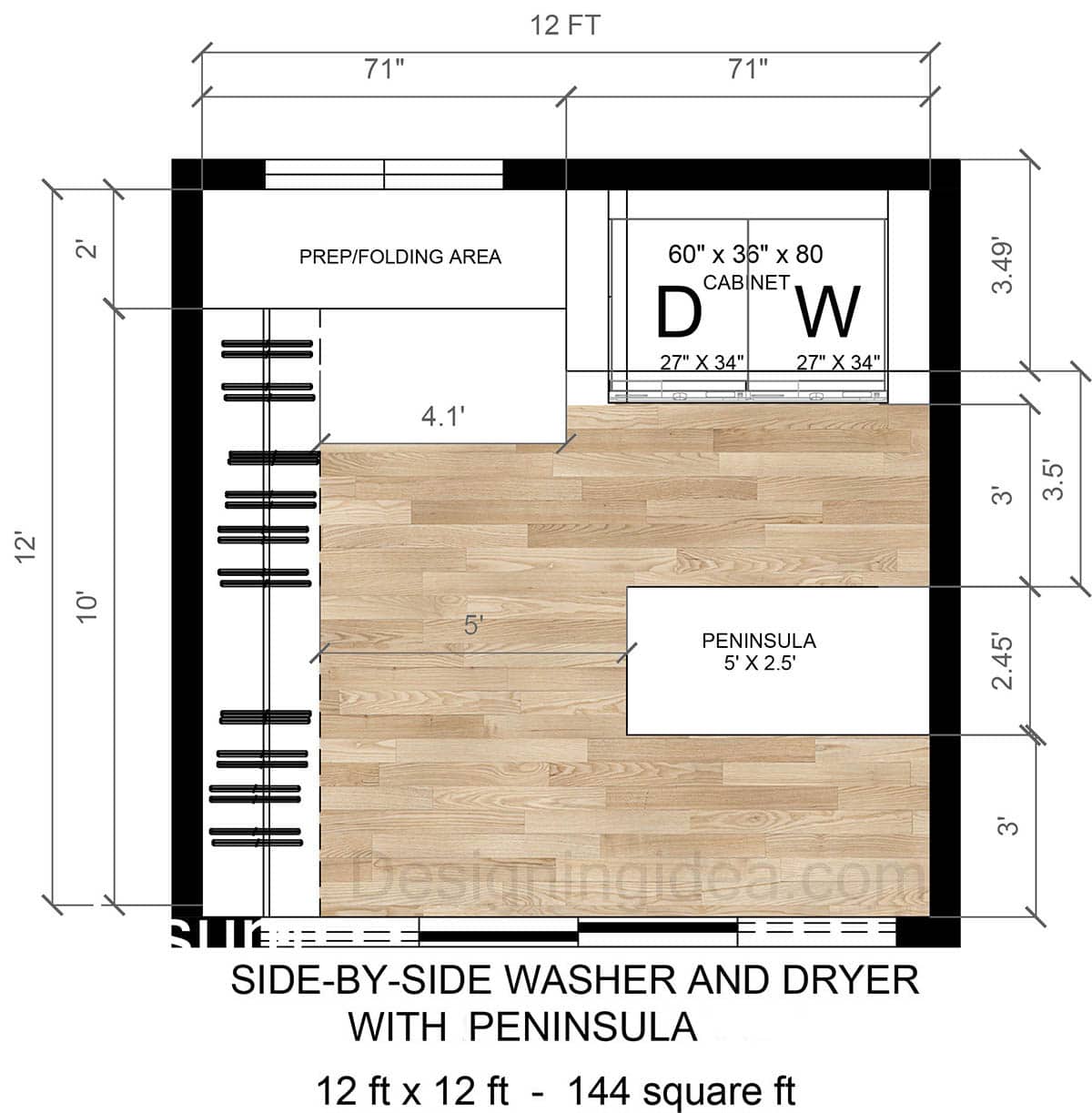
Layout Details: This master closet–laundry is laid out so you flow clockwise through three zones, wardrobe storage along the left wall, a service wall across the upper, and a task peninsula that projects from the right side. As you step in from the lower side, the room immediately feels open, and there’s a 5-foot‐wide swath of floor for space to move items and turn freely. To your left (the full 10-foot stretch of the left-hand wall) a 12-inch-deep shelf tops dual hanging rods, stacked one above the other, giving roughly 20 linear feet of short-hang capacity without crowding.
The entire upper wall becomes the service run. Starting at the left corner, a 2-foot-deep, 71-inch-long countertop forms a dedicated prep-and-folding station, with shallow wall cabinets above. At the right end of that run, a custom 60″ W × 36″ D × 80″ H cabinet hides a standard 27″-wide washer and dryer set behind full-height doors. The machines can sit side-by-side so their doors swing clear, yet the cabinet face aligns with the counter for a flush, furniture-grade look. A consistent 40-inch buffer in front lets you open both appliance doors without blocking any foot traffic.
Mid-room, a 5′ × 2 ½′ peninsula juts out from the right-side wall, stopping short of the wardrobe by three feet, and leaving similar 3-foot walkways around its outer edges. That peninsula does triple duty: a landing spot for sorted loads, a flat surface for suitcase packing, and a natural divider that keeps the “wet” end of the space (machines) separate from the hanging clothes. Because the peninsula is fixed to the wall instead of floating, its underside can house deep drawers for bulky linens or hidden laundry baskets. However, one could swap out the peninsula for a portable cart or island if desired.
Why It Works
- The island provides a large folding/sorting surface in the closet.
- Side-by-side units are straightforward to install and service.
- Extra area for hamper and storing essentials underneath the island keeps the floor uncluttered.
Dimensions:
- Closet Size: 12 ft x 12 ft (144 sq ft).
- Washer-Dryer Wall:
- Reserve a 5 to 6 ft wide x 36 in deep niche for side-by-side washer/dryer (54 in total width, plus a couple of inches for spacing).
- 36 in clearance in front of each appliance for loading.
- Peninsula: (Can use a portable island or cart)
- 3–4 ft wide x 4–5 ft long. 5’ x 2.5’
- Top at 36 in high (standard counter height) for folding.
- Add drawers or open shelving for baskets/bins.
- Utilities:
- Plan for dedicated 120 V or 240 V lines, and a venting duct behind the washer/dryer.
- Incorporate an access panel for maintenance.
Design Tips:
- Conceal to declutter. Go with full-height cabinet doors to conceal the washer and dryer, for a more boutique dressing space feel.
- Peninsula productivity. By using a T-shaped peninsula or portable island you can fold, iron, or plan outfits without taking up the long service counter.
- Balanced clearances. Maintain a minimum of 3-foot aisles all around to keep the peninsula useful and not obstructive, even when appliance doors are open.
- Task lighting layers. Use different layered lighting fixtures to minimize shadows Recessed cans wash the peninsula, under-cabinet LEDs brighten the counter, and a narrow uplight strip above the wardrobe shelf can soften the shadows below the hanging clothes.
General U.S. Building Code And Best Practices
- Appliance Clearances
- Most front-loading washers/dryers need about 48 inches of front clearance for door swing and operation, with a minimum of 36 inches being recommended.
- Ensure appliances are installed according to the manufacturer’s listed clearances and local codes (especially for dryer venting).
- Egress
- Hallways and walkways should maintain at least 36 inches of clear, unobstructed width in most residential settings.
- Doors leading into the space typically require at least a 32 inch clear opening.
- Ventilation
- Properly ventilate dryers to the exterior of the home.
- Check for local code mandates regarding booster fans or allowable duct lengths.
- If using a gas dryer, follow the code for gas line sizing, shutoff placement, and venting.
- Drainage & Overflow
- Some areas require a floor drain or a drain pan under second-story washers to minimize damage in the event of a leak.
- Verify that the closet floor is properly pitched if a pan or drain is required to ensure proper water runoff.
- Electrical Requirements
- Electric dryers typically require a 240 V dedicated circuit (30 amps). Washers usually need a 120 V, 15 or 20 amp circuit.
- Code may require GFCI or AFCI (Arc-Fault Circuit Interrupter) protection in certain locations; confirm with your own local requirements.
For more floor plans like this take a look at our laundry design optimizer.



